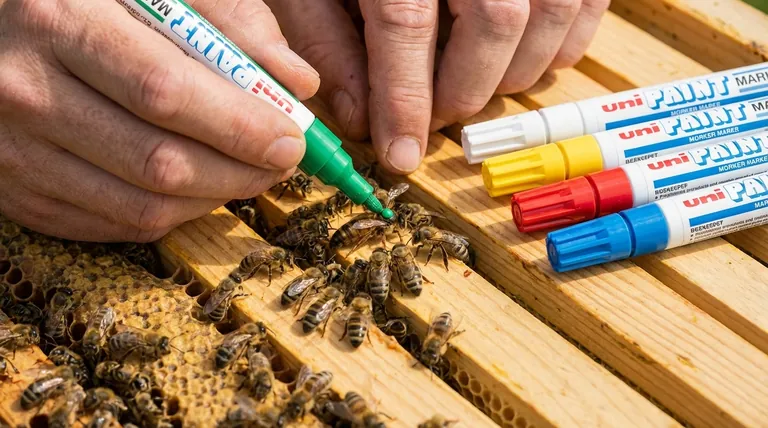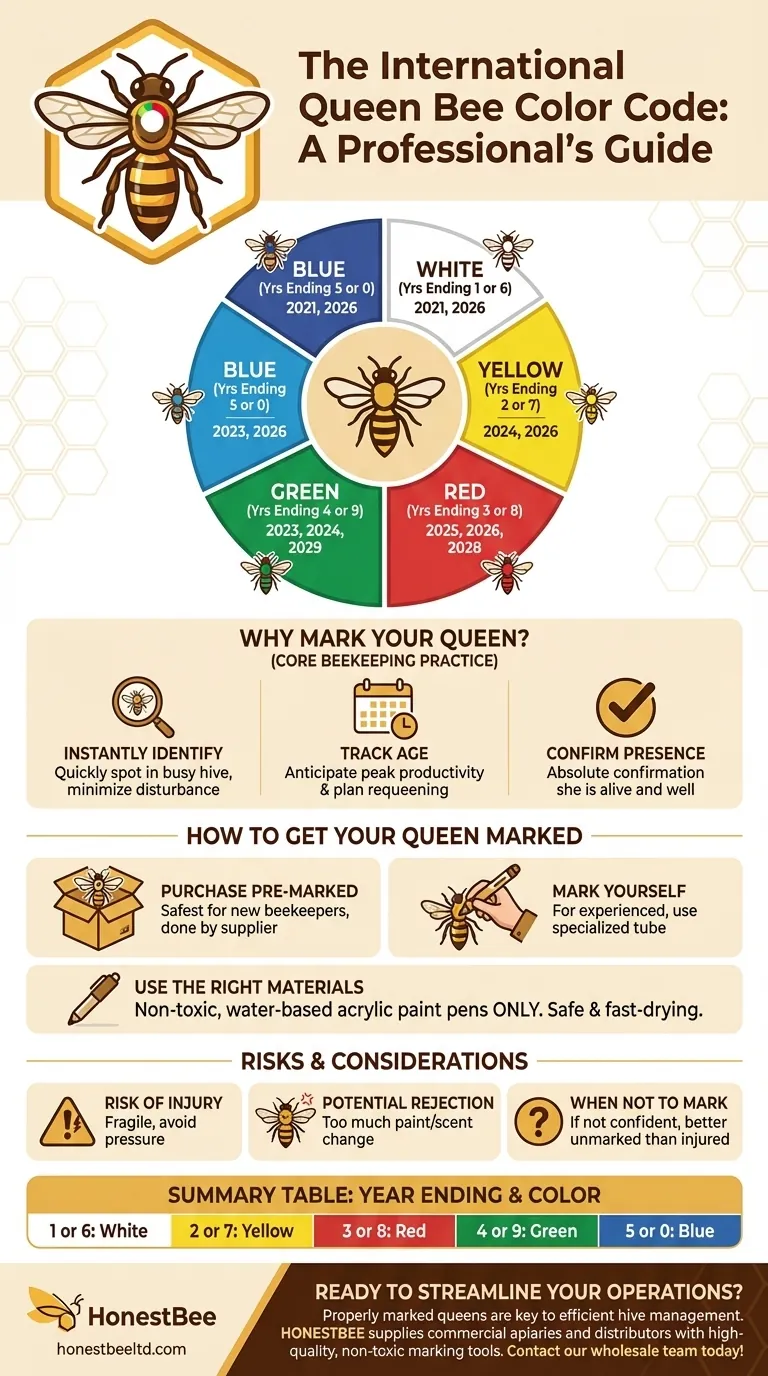The international color code for marking queen bees is a five-year rotation based on the last digit of the year. The system uses White for years ending in 1 or 6, Yellow for 2 or 7, Red for 3 or 8, Green for 4 or 9, and Blue for years ending in 5 or 0. This simple system allows a beekeeper to identify a queen's age at a glance.
While the colors themselves are a simple code, their true value lies in enabling quick, critical decisions about a hive's health and productivity. Marking a queen transforms hive inspection from a search-and-rescue mission into a rapid assessment.

Why Marking Your Queen is a Core Beekeeping Practice
A marked queen is the single most important piece of data you can have during a hive inspection. This small dot of color provides immediate information about the hive's most vital member.
Instantly Identify the Queen
Finding an unmarked queen in a bustling colony of 50,000 bees can be a time-consuming and disruptive task. A brightly colored dot on her thorax makes her stand out, reducing the time you need to have the hive open and minimizing disturbance to the colony.
Track the Queen's Age
A queen's egg-laying productivity typically peaks in her first or second year and declines thereafter. Knowing her age allows you to anticipate this decline and plan to replace her (a process called "requeening") before the colony's population and honey production suffer.
Confirm Her Presence
If you see eggs, you know a queen was present in the last three days. However, seeing the marked queen herself provides absolute confirmation that she is alive and well, which is crucial after a period of bad weather or when assessing a hive's recovery from stress. A common mnemonic to remember the color order is Will You Raise Good Bees?
The International Color Code Breakdown
This system is standardized worldwide, ensuring consistency whether you buy a queen from a commercial breeder or raise your own.
White: Years Ending in 1 or 6
For example, a queen hatched in 2021 or 2026 would be marked with white.
Yellow: Years Ending in 2 or 7
A queen from 2022 or 2027 would be marked yellow.
Red: Years Ending in 3 or 8
Queens hatched in 2023 or 2028 are marked with red.
Green: Years Ending in 4 or 9
A queen from 2024 or 2029 would be marked green.
Blue: Years Ending in 5 or 0
Queens hatched in 2025 or 2020 are marked with blue.
How to Get Your Queen Marked
You have two primary options for marking a queen, each with its own advantages depending on your experience level.
Purchase a Pre-Marked Queen
Most queen suppliers offer the service of marking the queen for a small fee before she is shipped. For new beekeepers, this is the safest and most highly recommended option.
Mark the Queen Yourself
Experienced beekeepers often mark queens they raise themselves. This requires gently capturing the queen, often with a specialized marking tube or cage, and applying a small dot of paint to the top of her thorax (the middle section of her body).
Use the Right Materials
It is critical to use non-toxic, water-based acrylic paint pens specifically designed for marking bees. These paints are safe for the queen and dry quickly without harming her.
Understanding the Risks and Considerations
While marking is a standard practice, it is not entirely without risk. It's important to proceed with caution and understanding.
The Risk of Injury
The primary risk is accidentally injuring the queen during the marking process. She is fragile, and excessive pressure can damage her legs, wings, or abdomen. This is why many beginners opt to buy pre-marked queens.
The Potential for Hive Rejection
If too much paint is applied or it gets on other parts of her body, her scent may be altered. In rare cases, this can cause the worker bees to reject and kill her, a process known as supersedure.
When Not to Mark a Queen
If you are not confident in your ability to handle the queen gently, it is better to leave her unmarked. An unmarked but healthy queen is far better than an injured or dead one. Practice on drones (male bees) first to develop your technique.
Making the Right Choice for Your Hive
Your approach to queen marking should align with your experience level and goals for the colony.
- If your primary focus is starting your first hive: Order a pre-marked queen from your supplier to eliminate risk and simplify your initial inspections.
- If your primary focus is raising your own queens: Master the technique of marking them yourself using the correct color for the year to maintain accurate records.
- If your primary focus is managing an established hive with an unmarked queen: You can choose to carefully mark her with the current year's color to establish a baseline for her age going forward.
Ultimately, adopting this simple color-coding system is one of the most effective steps you can take toward becoming a more informed and proactive beekeeper.
Summary Table:
| Year Ending In | Queen Marking Color |
|---|---|
| 1 or 6 | White |
| 2 or 7 | Yellow |
| 3 or 8 | Red |
| 4 or 9 | Green |
| 5 or 0 | Blue |
Ready to streamline your beekeeping operations? Properly marked queens are key to efficient hive management and maximizing honey production. HONESTBEE supplies commercial apiaries and beekeeping equipment distributors with the high-quality, non-toxic paint pens and marking tools needed for this essential practice. Let us help you equip your business for success. Contact our wholesale team today to discuss your supply needs!
Visual Guide

Related Products
- Queen Bee Marking Pen UNI Medium Point for Queen and Bee Marking
- Queen Bee Marking Pen POSCA Queen Marking Pens for Beekeeping Bee Markers
- Queen Bee Marking Tube Cage Bottle Catcher Holder with Clear Plastic Plunger Marker
- Professional Engraved Round Hive Number Tags for Beekeeping
- Brown Nicot Queen Cell Cups for Breeding Queen Bees Beekeeping
People Also Ask
- What are the color codes in the queen-marking system? Master Hive Management with the 5-Year Cycle
- How should a Posca pen be prepared for queen marking? Ensure a Safe, Precise Mark Every Time
- What is the purpose of a queen marking pen in beekeeping? Essential for Efficient Hive Management
- Why is marking a Queen bee important for beekeepers? Elevate Your Apiary Management
- What type of markers are commonly used for marking Queen bees? Choose the Safe, Non-Toxic Standard



















